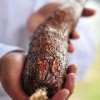An Indian graduate student has designed a mobile phone application that enables people with sight and hearing impairments to send and receive text messages.
The PocketSMS application was developed for Android smartphones, which are generally cheaper than Apple’s iPhones. The application converts text into Morse code vibrations so that users can “feel” the message. Continue reading Indian designer develops Morse-based texting for deaf phone users →
Insulating materials that could fit inside icepacks to transport and store vaccines more effectively are about to enter field trials in Vietnam.
The novel materials make use of the phase change — the point at which solids melt or liquids turn to solids — to keep the vaccines within a limited temperature range and prevent them from spoiling because of temperature variations.
If successful, the new vaccine carriers could be produced in India for use around the world, according to Shawn McGuire, an engineer at the global non-governmental organisation Program for Appropriate Technology in Health (PATH). Continue reading Phase-changing materials in trial to preserve vaccines →
 Cassava breeds that are resistant to two major viruses could soon be available to farmers in Africa.
Cassava breeds that are resistant to two major viruses could soon be available to farmers in Africa.
Cassava mosaic disease and brown streak disease stunt the growth and rot the roots of crops, respectively.
Mosaic disease alone destroys an estimated 35 million tonnes of African cassava a year — the difference between needing to import food into Africa and achieving food independence, according to researchers at the US-based Donald Danforth Plant Science Center.
The team has shown in the laboratory tests that genetically engineered (GE) tobacco plants resist brown streak disease. Their results will appear in Molecular Plant Pathology next month (August), Claude Fauquet, lead author of the study and director of cassava research at the centre, told SciDev.Net. Continue reading Virus-resistant cassava could be available by 2015 →
Technology policy editor at IEEE Spectrum Magazine
